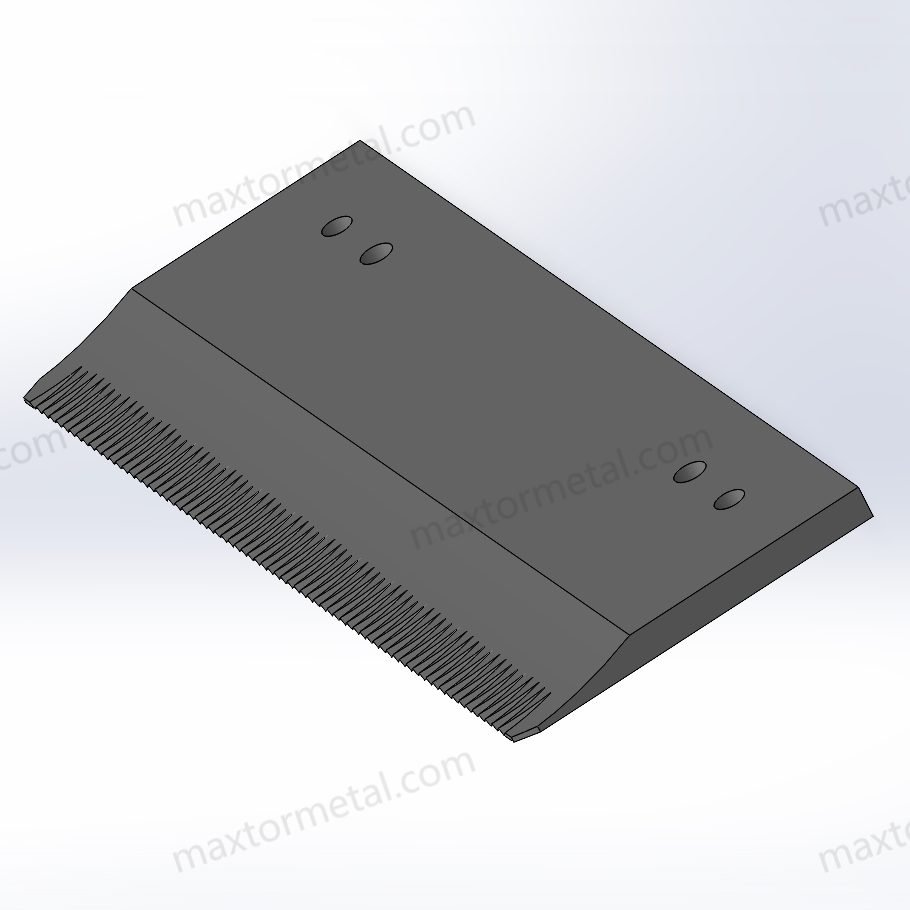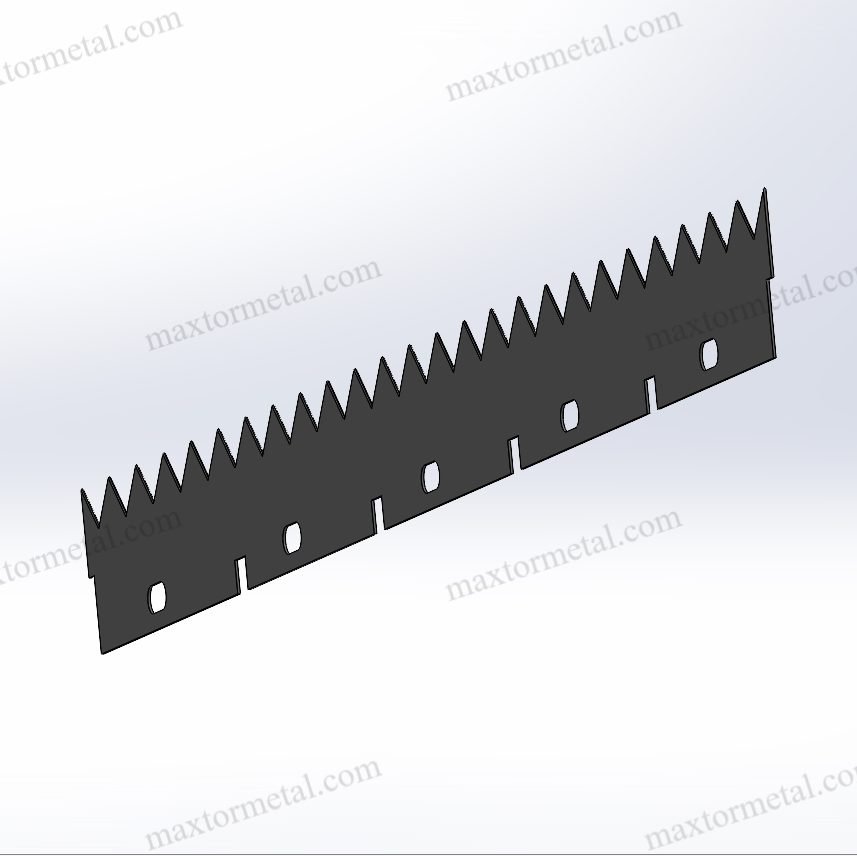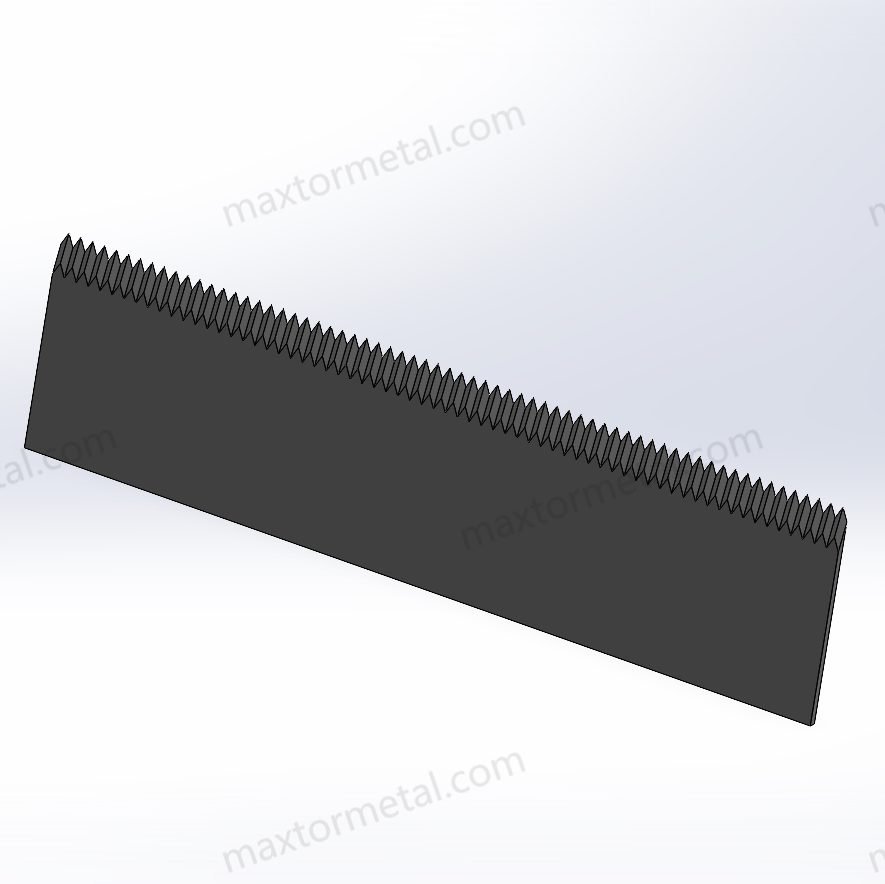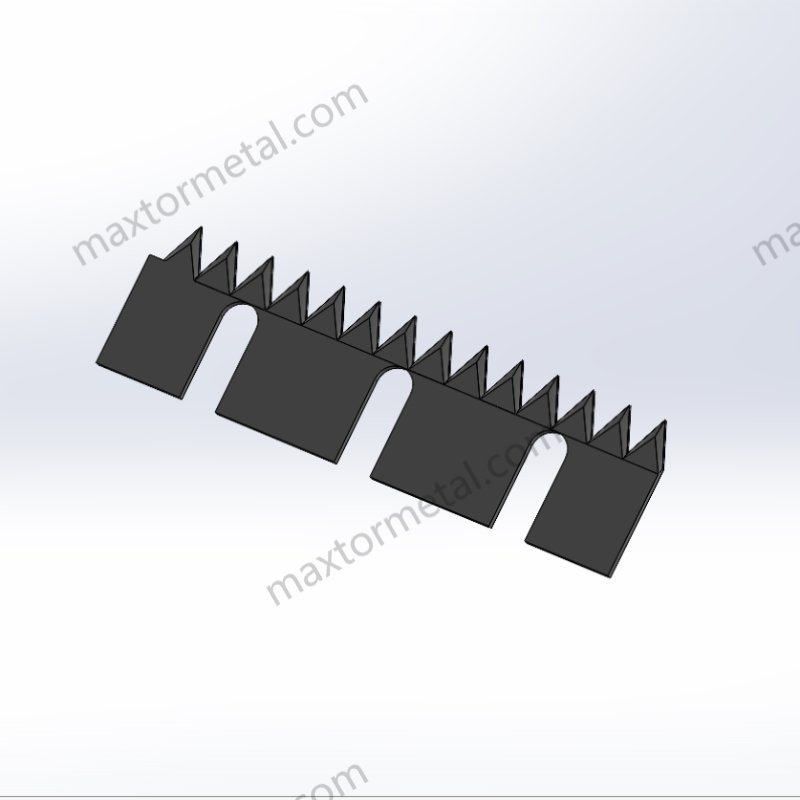الشفرات والسكاكين الصناعية تلعب دورًا محوريًا في التصنيع، ومعالجة المعادن، وإنتاج الورق، والعديد من الصناعات الأخرى. يؤثر أداؤها وطول عمرها بشكل مباشر على الكفاءة، وتكاليف الصيانة، والإنتاج الإجمالي. أحد العوامل الرئيسية التي تحدد متانة الشفرة هو تصلب الشفرات الصناعية عملية.
اختيار طريقة التصلب المناسبة يُحدث فرقًا كبيرًا في مقاومة تآكل الشفرة، ودقة القطع، وفعاليتها من حيث التكلفة. أكثر طريقتي التصلب شيوعًا هما التصلب والتصلب السطحي. لكل منهما مزايا فريدة، ومناسبة لتطبيقات مختلفة. ستُقدم هذه المقالة مقارنة مُعمّقة لهاتين الطريقتين، مما يُساعد الشركات على اختيار أفضل عملية تصلب لشفرات القطع الصناعية الخاصة بها.

1. فهم عملية تصلب الشفرة
تتعرض الشفرات والسكاكين الصناعية لضغط شديد أثناء عمليات القطع والتقطيع والمعالجة. وبدون التصلب الصناعي المناسب، تتآكل بسرعة، مما يقلل من دقة القطع ويزيد من تكاليف التشغيل. ولإطالة عمر الشفرات، يستخدم المصنعون تقنيات المعالجة الحرارية، مثل التصلب وتصلب السطح، لتحسين صلابتها ومقاومتها للتآكل وأدائها العام.
كيف يُحسّن التصلب أداء الشفرة
يجب أن تكون السكاكين الصناعية صلبة بما يكفي لتحمل التآكل والحفاظ على حدتها، مع الحفاظ على متانتها لامتصاص الصدمات دون أن تنكسر. تُقوّي عملية تقوية الشفرة هيكل المعدن، مما يجعل حافة القطع أكثر مقاومة للتشوه والكسر.
فوائد تقوية الشفرة:
✔ عمر افتراضي ممتد - يقلل من التآكل والتلف، مما يقلل من تكرار الاستبدال.
✔ تحسين مقاومة التآكل - يتحمل الاحتكاك المستمر الناتج عن قطع المواد الكاشطة.
✔ تحسين أداء القطع - يحافظ على الحدة للحصول على قطع دقيقة ومتسقة.
✔ كفاءة التكلفة العالية - يقلل من تكاليف الصيانة ووقت التوقف والاستبدال.
بدون تصلب، شفرات الآلة إن الأنابيب المصنوعة من الفولاذ عالي الكربون أو الفولاذ السبائكي سوف تتآكل بسرعة، مما يؤدي إلى توقف متكرر وزيادة تكاليف الإنتاج.
العلم التكنولوجي وراء التصلب
يُغيّر التصلب البنية الدقيقة لشفرات الفولاذ، وعادةً ما يُحوّل بنية الفريت والبيرلايت اللينة إلى مارتنسيت صلب من خلال التبريد السريع. تتضمن العملية عمومًا ما يلي:
- التدفئة - يتم تسخين الشفرة إلى درجة حرارة حرجة (عادة 800-1000 درجة مئوية، اعتمادًا على نوع الفولاذ).
- التبريد - يتم تبريد الشفرة بسرعة في الماء أو الزيت أو الهواء لاحتجاز البنية المارتنسيتية الصلبة.
- هدأ (اختياري) - يتم إعادة تسخين الشفرة بدرجة حرارة أقل لتحقيق التوازن بين الصلابة والمتانة.
تحدد طرق التصلب المختلفة مقدار الشفرة التي تخضع للتحول، مما يؤثر على أدائها العام.
المبادئ الأساسية لطرق التصلب
كلاهما من خلال التصلب والتصلب السطحي تُقوّي الشفرات الصناعية بطرق مختلفة. يكمن الاختلاف الرئيسي في مقدار تقوية هيكل الشفرة:
| طريقة التصلب | عملية | توزيع الصلابة | صلابة القلب | التطبيقات الشائعة |
| من خلال التصلب | يتم تسخين الشفرة بأكملها وإخمادها | صعب في كل مكان | صلابة أقل | قطع عالي التأثير وتطبيقات شديدة التحمل |
| تصلب السطح | الطبقة الخارجية فقط هي التي يتم تصلبها | سطح خارجي صلب، قلب أكثر ليونة | صلابة أعلى | تطبيقات مقاومة للتآكل وامتصاص الصدمات |
ما هي الصناعات التي تعتمد على تقوية الشفرات؟
تعتبر مقاومة التآكل للشفرات الصناعية أمرًا بالغ الأهمية في قطاعات مثل:
- معالجة Metal - قطع وختم وقص المعادن الصلبة.
- الورق والطباعة - شفرات التقطيع والتثقيب في إنتاج الورق عالي السرعة.
- إعادة تدوير البلاستيك - شفرات الحبيبات لمعالجة البلاستيك الصلب.
- الخشب والمنسوجات - قطع المواد المنسوجة والأخشاب بأقل قدر من التآكل.
من خلال اختيار المعالجة الحرارية الصحيحة للشفرة، يضمن المصنعون أداء سكاكينهم الصناعية بكفاءة مع تقليل وقت التوقف والتكاليف.

2. من خلال التصلب
التعريف والعملية
التصلب العميق، المعروف أيضًا باسم التصلب الكامل، هو عملية معالجة حرارية للمعادن تضمن صلابة موحدة في جميع أنحاء هيكل الشفرة. يتحقق ذلك بتسخين الشفرة فوق درجة حرارة تحولها الحرجة، ثم تبريدها بسرعة (التبريد) لتثبيت هيكل مارتنسيتي متصلب بالكامل.
يؤثر وسط الإطفاء بشكل كبير على الخصائص النهائية:
| وسط الإطفاء | معدل التبريد | التأثير على الشفرة |
| ماء | سريع جدا | أعلى صلابة ولكن هشاشة متزايدة |
| زيت | معتدل | توازن جيد بين الصلابة والمتانة |
| هواء | بطيئ | صلابة أقل ولكن صلابة متزايدة |
بعد التبريد، يمكن معالجة الشفرة لضبط صلابتها ومنع الهشاشة المفرطة.
الميزات الرئيسية والمزايا والعيوب
ميزات التصلب الكامل
✔ التحول المارتنسيتي الكامل، مما يضمن بنية صلبة بشكل متناسق.
✔ يعزز متانة الشفرة للتطبيقات ذات الأحمال العالية.
✔ مثالي للشفرات الصناعية السميكة التي تتطلب مقاومة موحدة للتآكل.
مزايا التصلب الكامل
✔ صلابة موحدة - يحافظ على أداء القطع الثابت.
✔ مقاومة ممتازة للتآكل - يقلل من تدهور الحافة بمرور الوقت.
✔ عمر أطول للشفرة - إن قلة عمليات الاستبدال تعني انخفاض التكاليف على المدى الطويل.
عيوب التصلب الكامل
✘ مقاومة أقل للتأثير - أكثر عرضة للتشقق تحت تأثير الصدمات.
✘ تكلفة أولية أعلى - يتطلب معدات معالجة حرارية متخصصة.
الصناعات والتطبيقات
تُستخدم الشفرات المقواة على نطاق واسع في الصناعات التي تتطلب مقاومة عالية للتآكل وصلابة ثابتة عبر حافة القطع.
| صناعة | تطبيق | لماذا تستخدم من خلال التصلب؟ |
| معالجة Metal | القص، التقطيع، الختم | يحافظ على الحدة أثناء قطع المعادن الصلبة |
| النجارة | شفرات المنشار، سكاكين التقطيع | يضمن المتانة تحت القطع عالي السرعة |
| إعادة التدوير | آلات التقطيع والحبيبات | يتحمل المعالجة الثقيلة للبلاستيك والمطاط |
| الورق والمنسوجات | التثقيب والشق | يتطلب قطعًا دقيقًا ودقيقًا مع الحد الأدنى من التشوه |
دراسة حالة: تحسين الإنتاجية باستخدام شفرات صلبة
استخدمت شركة لمعالجة الفولاذ سكاكين مُقسّاة السطح لتقطيع صفائح معدنية سميكة، لكنها عانت من تشققات متكررة في الشفرات. بعد التحول إلى شفرات القطع الصناعية المُقسّاة بالكامل، قامت بما يلي:
✔ زيادة عمر الشفرة بمقدار 40%.
✔ تم تقليل حوادث كسر الشفرة بواسطة 60%.
✔ انخفاض تكاليف التوقف عن العمل بمقدار $20,000 سنويًا.
يوضح هذا كيف تؤثر طريقة المعالجة الحرارية الصحيحة بشكل كبير على الكفاءة التشغيلية.
متى يجب عليك الاختيار من خلال التصلب؟
✅ إذا كان تطبيقك يتطلب صلابة ثابتة عبر الشفرة.
✅ إذا كنت بحاجة إلى مقاومة عالية للتآكل في ظروف القطع القاسية.
✅ إذا كان سمك الشفرة لديك يسمح باختراق عميق للصلابة.

3. تصلب السطح
التعريف والعملية
تصلب السطح، المعروف أيضًا باسم تصلب الغلاف، هو عملية معالجة حرارية للمعادن مصممة لتعزيز مقاومة تآكل الشفرة بزيادة صلابتها في الطبقة الخارجية فقط مع الحفاظ على صلابة ومرونة القلب. تُستخدم هذه الطريقة على نطاق واسع في شفرات القطع الصناعية، حيث يكون امتصاص الصدمات والحفاظ على الحافة أمرًا بالغ الأهمية.
بخلاف التصلب السطحي، الذي يُغيّر بنية الشفرة بأكملها، يُطبّق التصلب السطحي الحرارة أو الانتشار الكيميائي على الطبقات الخارجية فقط. تشمل أكثر تقنيات التصلب السطحي شيوعًا ما يلي:
طرق تصلب الأسطح الشائعة
| طريقة | عملية | عمق الصلابة | التطبيقات الرئيسية |
| التصلب بالحث | يستخدم المجالات الكهرومغناطيسية لتسخين سطح الشفرة قبل الإطفاء السريع. | 1-5 ملم | تطبيقات التآكل العالية مثل شفرات المنشار, سكاكين القص. |
| التكرير | يتم نشر الكربون على سطح الشفرة عند درجات حرارة عالية، ثم يتم تبريده. | 0.5–2 ملم | التروس وأدوات القطع والشفرات المقاومة للصدمات. |
| نيترة | يقوم بإدخال النيتروجين إلى سطح الفولاذ لتكوين طبقة صلبة دون إخماد. | 0.2–1 ملم | التطبيقات التي تتطلب مقاومة شديدة للتآكل، مثل سكاكين القطع البلاستيكية. |
توفر كل من هذه العمليات فوائد فريدة اعتمادًا على ظروف القطع المقصودة للشفرة ومتطلبات المواد.
الميزات الرئيسية والمزايا والعيوب
ميزات تصلب السطح
✔ يقوي الطبقة الخارجية فقط، ويترك القلب صلبًا ومرنًا.
✔ يوفر مقاومة ممتازة لتآكل الشفرة للاحتفاظ بالحافة لفترة طويلة.
✔ يقلل من خطر كسر الشفرة عند التعرض لصدمة مفاجئة.
مزايا تصلب السطح
✔ متانة معززة - ال حتتمتع القشرة الخارجية الصلبة بمقاومة للتآكل، مما يحسن الأداء.
✔ تحسين امتصاص الصدمات - النواة الداخلية الناعمة تمنع الكسور المفاجئة.
✔ التصنيع الموفر للتكلفة - انخفاض استهلاك الطاقة مقارنة بالتصلب الكامل.
عيوب تصلب السطح
✘ عمق صلابة محدود - يتم تقوية طبقة رقيقة فقط من الشفرة.
✘ غير مثالي للقطع الشاق - يمكن أن تتآكل بشكل أسرع تحت الضغط الشديد.
الصناعات والتطبيقات
يتم استخدام تصلب السطح على نطاق واسع في الصناعات حيث تكون مقاومة التآكل وامتصاص الصدمات ضرورية.
| صناعة | تطبيق | لماذا نستخدم تقوية السطح؟ |
| معالجة الأغذية | سكاكين تقطيع اللحوم والتعبئة والتغليف | يحافظ على حافة حادة دون التشقق عند التعرض للصدمات. |
| إعادة تدوير البلاستيك | سكاكين التقطيع والتحبيب | يعمل على تعزيز عمر الشفرة لقطع البلاستيك الصلب. |
| زراعة | شفرات الحصاد والحش والمعالجة | يحسن كفاءة القطع مع مقاومة الأوساخ والحطام. |
| المنسوجات والورق | شفرات التثقيب والتقطيع | قطع دقيق وعالي السرعة مع الحد الأدنى من التآكل. |
دراسة حالة: تحسين الإنتاجية باستخدام شفرات مُقوّاة السطح
استخدم مصنع لإعادة تدوير البلاستيك سكاكين مُصلَّاة بالكامل لقطع المواد البلاستيكية الصلبة، لكنه واجه استبدالًا متكررًا للشفرات بسبب الكسور الناتجة عن الصدمات. بعد التحول إلى سكاكين مُصلَّاة سطحيًا مُنتَرِدة، لاحظوا ما يلي:
✔ عمر أطول للشفرة 50%، مما يقلل من تكاليف الاستبدال.
✔ 30% وقت تعطل أقل، مما يحسن الكفاءة التشغيلية.
✔ أداء قطع معزز، مع الحفاظ على الحواف الأكثر حدة لفترة أطول.
يسلط هذا المثال الضوء على كيفية اختيار المعالجة الحرارية الصحيحة للشفرة لتحسين المتانة والفعالية من حيث التكلفة.
متى يجب عليك اختيار تقوية السطح؟
✅ إذا كان امتصاص الصدمات ضروريًا لتجنب التقطيع أو فشل الشفرة.
✅ إذا كانت الفعالية من حيث التكلفة وانخفاض الاستثمار الأولي هي الأولويات.
✅ إذا كنت بحاجة إلى التوازن بين الصلابة والمرونة.

4. اختيار طريقة التصلب الصحيحة
يتطلب اختيار طريقة تصلب الشفرة الصناعية الصحيحة تحليل عوامل متعددة، بما في ذلك مادة الشفرة، وظروف القطع، والفعالية من حيث التكلفة.
العوامل الرئيسية التي يجب مراعاتها
| عامل | من خلال التصلب | تصلب السطح |
| نوع المادة | الأفضل للصلب عالي الكربون وعالي السبائك | يعمل بشكل جيد مع الفولاذ منخفض السبائك |
| ظروف القطع | الأفضل للبيئات عالية التآكل والحمل | مثالي للتطبيقات المعرضة للصدمات |
| سمك الشفرة | الأفضل للسكاكين السميكة وشفرات المنشار | الأفضل للسكاكين الرقيقة والمرنة |
| طول العمر | عادةً ما يكون عمر أطول بمقدار 30–50% | عمر افتراضي متوسط ولكن تكلفة أقل |
| اعتبارات التكلفة | تكلفة أولية أعلى ولكن عدد أقل من البدائل | تكلفة أولية أقل ولكن قد تتطلب استبدالات أكثر تكرارا |
تحليل التكلفة: الاستثمار قصير الأجل مقابل الاستثمار طويل الأجل
رغم أن الشفرات المُصلَّاة سطحيًا تتطلب استثمارًا أوليًا أقل، إلا أنها قد تبلى أسرع من السكاكين المُصلَّاة تمامًا في البيئات عالية الضغط. يجب على الشركات تقييم ما إذا كانت الوفورات قصيرة الأجل تفوق تكاليف التشغيل طويلة الأجل.
مثال على مقارنة التكلفة:
| نوع الشفرة | التكلفة الأولية لكل شفرة | متوسط العمر | تكلفة الاستبدال السنوية (لـ 100 شفرة) |
| سكين متصلب بالكامل | $100 | 12 شهرًا | $10,000 |
| سكين مقوى السطح | $60 | 6 أشهر | $12,000 |
🔹 في حين تتطلب الشفرات المقواة بالكامل استثمارًا أوليًا أعلى، فإن عمرها الأطول يؤدي إلى توفير التكاليف بمرور الوقت.
دراسة حالة: اختيار أفضل طريقة للتصلب
احتاجت شركة نجارة إلى الاختيار بين التصلب السطحي والتصلب الصناعي لشفرات المنشار الصناعية. وشملت متطلباتها ما يلي:
- دورات قطع طويلة مع الحد الأدنى من وقت التوقف.
- مقاومة عالية للتآكل عند قطع الأخشاب الصلبة.
- كفاءة التكلفة المتوازنة.
بعد التحليل، اختاروا شفرات المنشار المقواة، مما أدى إلى:
✔ 35% عدد أقل من عمليات استبدال الشفرات سنويًا.
✔ 20% تكاليف صيانة أقل.
✔ دقة قطع ثابتة على مدى فترات أطول.

5. اتجاهات الصناعة وتقنيات التصلب المتقدمة
يشهد مجال تقسية الشفرات الصناعية تطورًا سريعًا، حيث تتطلب الصناعات موادًا عالية الأداء ومقاومة للتآكل وعمليات تصنيع فعالة من حيث التكلفة. وتُسهم التطورات في تقنيات المعالجة الحرارية في جعل شفرات الآلات وشفرات القطع الصناعية أكثر متانة وفعالية، مع تحسين كفاءة الطاقة في الإنتاج.
طرق التصلب الجديدة تُحدث تحولاً في الصناعة
لا تزال عمليات التصليب التقليدية وتصليب الأسطح شائعة الاستخدام، إلا أن الطرق الأحدث تكتسب زخمًا متزايدًا. توفر هذه العمليات المتقدمة تحكمًا أفضل في الصلابة، واستهلاكًا أقل للطاقة، ومتانة أفضل للشفرة.
1. التصلب بالليزر
✔ يستخدم ليزر عالي الكثافة لتسخين سطح الشفرة بسرعة.
✔ ينشئ طبقة صلبة يتم التحكم فيها بدقة دون الحاجة إلى التبريد.
✔ مثالي لـ: السكاكين الصناعية الرفيعة وعالية الدقة (على سبيل المثال، قطع الورق، ومعالجة الأغذية).
2. النترتة البلازمية
✔ يقوم بضخ النيتروجين إلى الفولاذ تحت بيئة مفرغة من الهواء.
✔ ينتج سطحًا شديد الصلابة (مقاومة للتآكل أعلى من الكربنة).
✔ مثالي لـ: شفرات الحبيبات، وسكاكين التقطيع، وأدوات القطع عالية التآكل.
3. التصلب بالتبريد العميق
✔ يتضمن تجميد الشفرات بعمق إلى درجات حرارة منخفضة تصل إلى -196 درجة مئوية (-320 درجة فهرنهايت).
✔ يعزز البنية الدقيقة للمعادن، مما يقلل الضغوط الداخلية.
✔ مثالي لـ: الشفرات عالية التأثير المستخدمة في قص المعادن وقطع البلاستيك.
| طريقة التصلب | عملية | مزايا | أفضل التطبيقات |
| التصلب بالليزر | تسخين سريع بالليزر لسطح الشفرة | تحكم دقيق، لا حاجة للتبريد | سكاكين صناعية رفيعة |
| النترتة البلازمية | انتشار النيتروجين في درجات الحرارة العالية | مقاومة شديدة للتآكل وصديقة للبيئة | سكاكين التحبيب والتقطيع |
| التصلب بالتبريد العميق | تجميد الفولاذ إلى درجات حرارة منخفضة للغاية | يحسن الصلابة ويقلل التوتر | شفرات عالية التأثير |
الطلب المتزايد على المواد عالية المقاومة للتآكل
الطلب المتزايد على السكاكين الصناعية طويلة الأمد يدفع المصنّعين نحو استخدام مواد فائقة المقاومة للتآكل. ومن بين هذه الاتجاهات:
✔ شفرات من الفولاذ عالي السرعة (HSS) - دقة قطع محسنة وطول العمر.
✔ شفرات ذات أطراف من الكربيد - صلابة شديدة لتطبيقات قطع المعادن.
✔ سكاكين مطلية بالسيراميك - مقاومة عالية للتآكل لمعالجة الأغذية والمنسوجات.
وتسمح هذه التطورات لشفرات الماكينة بالعمل لفترة أطول بين عمليات الاستبدال، مما يقلل من تكاليف الصيانة ويحسن الكفاءة.
التصنيع الذكي والأتمتة في المعالجة الحرارية
تتضمن مرافق المعالجة الحرارية الحديثة الآن التحكم الآلي والدقيق المعتمد على الذكاء الاصطناعي، مما يضمن:
✔ مستويات صلابة ثابتة عبر دفعات الإنتاج الكبيرة.
✔ تقليل استهلاك الطاقة، مما يجعل العملية أكثر صديقة للبيئة.
✔ تحسين مراقبة الجودة، وتقليل هدر المواد وضمان صلابة موحدة للشفرة.

6. نانجينغ Metalحلول الشفرات الاحترافية من 's
مع 18 عامًا من الخبرة، تتخصص شركة Nanjing Metal في شفرات القطع الصناعية المخصصة وحلول المعالجة الحرارية عالية الأداء. نحن نقدم:
- شفرات القطع الصناعية المخصصة - نقوم بتصميم شفرات لقطع المعادن، وتقطيع الورق، وتقطيع البلاستيك، ومعالجة الأغذية.
- تقنيات التصلب المتقدمة – نحن نستخدم تقنيات التصلب المتقدمة وتصلب السطح المصممة خصيصًا لتطبيقات مختلفة.
- استشارة الخبراء - تخضع كل شفرة لاختبارات صلابة صارمة لضمان المتانة.
7. الأسئلة الشائعة
1. ما هو الفرق الرئيسي بين التصلب الكامل والتصلب السطحي؟
✔ التصلب الكامل: يقوي الشفرة بأكملها، مما يوفر مقاومة موحدة للتآكل.
✔ تصلب السطح: يعمل فقط على تصلب الطبقة الخارجية، مما يحسن امتصاص الصدمات.
2. كيف أحدد طريقة التصلب المناسبة لسكاكيني الصناعية؟
خذ بعين الاعتبار ما يلي:
🔹 نوع المادة - تستفيد المواد الأكثر صلابة من التصلب من خلال عملية التصلب، بينما تعمل الفولاذ الأكثر ليونة بشكل جيد مع التصلب السطحي.
🔹 ظروف القطع - تتطلب البيئات عالية التأثير تقوية السطح لتحقيق المرونة.
🔹 اعتبارات الميزانية - تدوم السكاكين المقواة لفترة أطول ولكن تكاليفها الأولية أعلى.
3. كيف يؤثر تصلب الشفرة على التكاليف على المدى الطويل؟
| نوع الشفرة | التكلفة الأولية لكل شفرة | عمر | تكاليف الاستبدال السنوية (لـ 100 شفرة) |
| سكين متصلب بالكامل | $100 | 12 شهرًا | $10,000 |
| سكين مقوى السطح | $60 | 6 أشهر | $12,000 |
🔹من خلال التصلب يوفر التكاليف بمرور الوقت بسبب متانته الطويلة.
4. كيف تضمن Nanjing Metal جودة الشفرة؟
✔ مرافق المعالجة الحرارية الحديثة.
✔ اختبارات صلابة صارمة وعمليات تفتيش الجودة.
✔ خبرة محددة في الصناعة قطع المعادن، معالجة الورق، وإعادة تدوير البلاستيك، و تقطيع الطعام.
اختيار الصحيح تصلب الشفرات الصناعية تعتمد الطريقة على طلبك والمادة المستخدمة وميزانيتك. سواء كنت بحاجة إلى سكاكين مقواة بالكامل للقطع عالي الضغط أو شفرات صلبة السطح لامتصاص الصدمات، فإن اتخاذ الاختيار الصحيح سيحسن الأداء ويقلل التكاليف.
🔹هل تحتاج إلى نصيحة من الخبراء؟ اتصل بنا اليوم للحصول على استشارة مجانية!
مراجع
- ASM الدولية. (2022).دليل المعالجة الحرارية"."
- معهد القطع Metal. (2023).تقرير بحثي حول متانة الشفرة"."


